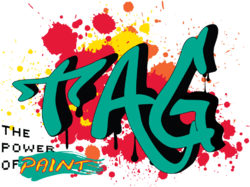Tag: The Power of Paint
| This article is non-canon. | ||
|---|---|---|
The subject matter of this article does not take place in the "real" Half-Life and Portal universe and is considered non-canon. |
| This article would greatly benefit from the addition of one or more new images. | ||
|---|---|---|
Please upload one or several relevant images (from canonical / official sources) and place it here. Once finished, this notice may be removed. |
Tag: The Power of Paint is a first-person shooter, platform, and puzzle video game developed by Tag Team and released free online in 2008 on PC, as the junior game project of seven RTIS and BFA students attending DigiPen Institute of Technology. Made in cel-shaded animation, the game was chosen from ten IGF Student Showcase Finalists as winner of the Best Student Game Award.
After the release of Tag, Valve discovered it and hired the entire development team to work for them, and reuse the paint concept in Portal 2 as the Mobility Gels.[1] Before Portal 2, they also worked on Left 4 Dead 2.
Another game created by DigiPen students, Narbacular Drop, released in 2005, also dragged the attention of Valve. The whole team was also hired to work for Valve, which resulted in the first Portal.
Gameplay[edit]
While navigating through an urban, black and white landscape, the player uses only one weapon, a large super-soaker loaded with a never-ending supply of paint. By traversing the 9 maps and solving their puzzles, players gain access to additional paint colors. The player can then change the physics of the level as those colors are used to paint the surfaces of each level. However, game progress cannot be saved.
The paint comes in three colors: green paint, jumping the player high and far depending on initial speed (turned into the blue Repulsion Gel in Portal 2); red paint, increasing acceleration and top speed allowing the player to pull off a long jump (turned into the orange Propulsion Gel); blue paint, allowing the player to stick to and walk on any surface, vertical or horizontal (turned into the purple Adhesion Gel, developed but removed from the final game). A fourth matter, with a water-like appearance, is used to cleanse the paint (turned into the Cleansing Gel).
Awards and honors[edit]
- IGF Student Showcase Winner (2009)
- Ranked #2 in IGN's Independent's Day Vol. 17: Top 10 Indie Games (2008)
Gallery[edit]
References[edit]
- ↑ Valve Hires DigiPen Team; Seemingly for Portal 2 on Shacknews



